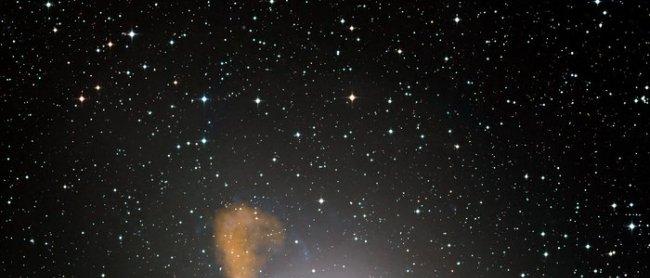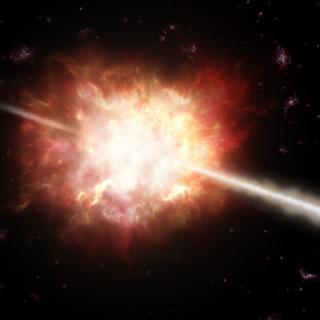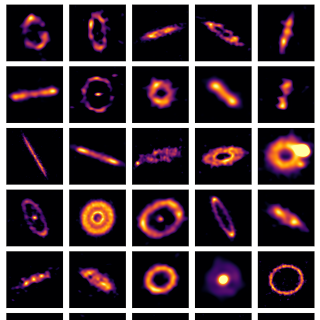The centres of massive galaxies are among the most exotic regions in the universe. They harbour supermassive black hole, with masses of at least one million, and reaching thousands of millions of times the mass of the Sun. These black holes can cause a great deal of matter to fall towards them, producing the emission of huge quantities of energy before they finally fall into the black hole. In addition during this period (the "active phase" of the galaxy, referred to as an AGN or Active Galactic Nucleus) matter is expelled from outside the black hole in the form of high velocity (relativistic) jets, which can produce violent shocks with the surrounding matter.
For some time it has been thought that all of this emission of radiation and particles, and the growth of the black hole itself, should influence the way in which these galaxies form stars, making this star formation more difficult. "This influence " explains the first author of the article, Ignacio Martín Navarro, who studied for his doctorate at the Instituto de Astrofísica de Canarias (IAC) and the Universidad de La Laguna (ULL) and who is at present a researcher at the University of California at Santa Cruz (US) and the Max Planck Institut für Astronomie (Heidelberg, Germany), "allows us to explain the observed relations such as that between the mass of the central black hole and the total stellar mass. In fact without this "feedback" the simulations of the formation and the evolution of massive galaxies fail completely, both in reproducing their properties and in the number of galaxies predicted with a given mass". However until now there has been no observational evidence in favour of this idea which has become increasingly well known and established.
"In this work", adds Ignacio, "we analyse the spectra of the centres of 74 galaxies using data from the Hobby-Eberly Telescope Massive Galaxy Survey with the aim of finding out how the rate of star formation in these systems ahs changed during their lifetimes (the "star formation history"). To do this we used codes which allow us to compare the observed spectra with those predicted by models of stellar evolution. In this way we can learn how many stars of different ages there are in each of the observed galaxies".
"As a result of this analysis", explains Tomás Ruiz Lara, a researcher at the IAC and one of the authors of the Nature article, "we can explore the different star formation histories in galaxies with black holes of different masses. Our findings suggest clearly that, in effect, supermassive central black holes can affect the formation of stars throughout the lifetime of the galaxy, and that this effect depends on their masses".
According to this analysis, galaxies with more massive black holes in their centres show a faster rate of initial star formation, which gives rise to a more massive back hole which then can slow down the star formation in the galaxy. On the contrary, this process is produced much more slowly in those stars which currently harbour less massive black holes, starting with a lower star formation efficiency. " To be specific", stresses Ruiz Lara, "we find that the galaxies with the most massive central back holes form the major part of their masses (95%) up to 4,000 million years before the galaxies with less massive central black holes. But at the same time, the more recent star formation (during the last 700 million years) is greater for galaxies with less massive black holes".
The fact that the mass of these black holes is related to the quantity of matter and energy emitted during their AGN phase (which was well known), taken together with the new results, confirm a simple scenario previously envisaged, which has been clearly strengthened thanks to this study. To form stars efficiently, cold gas and dust are needed. However the energy and the particles emitted from the centre of a galaxy during its AGN phase can heat the interstellar medium through which they pass, reducing the possibility of star formation. For higher emission (which implies for greater mass of the central black hole), lower will be the efficiency of the host galaxy in forming its stars. This gives a ready explanation of why galaxies with the most massive black holes suppress their initial star formation first, so that more recent star formation is not favoured.
These results published in Nature which have a key importance in modern astrophysics and have been sought with great intensity during the past 20 years, offer key observational evidence for widely accepted hypotheses which are basic for understanding how the most massive galaxies form and evolve.
Paper: Ignacio Martín-Navarro et al. "Black-hole regulated star formation in massive galaxies", Nature. doi:10.1038/nature24999
Contacts:
Ignacio Martín-Navarro: imartinn [at] ucsc.edu (imartinn[at]ucsc[dot]edu)
Tomás Ruiz Lara: tomas.ruiz [at] iac.es (tomas[dot]ruiz[at]iac[dot]es)



